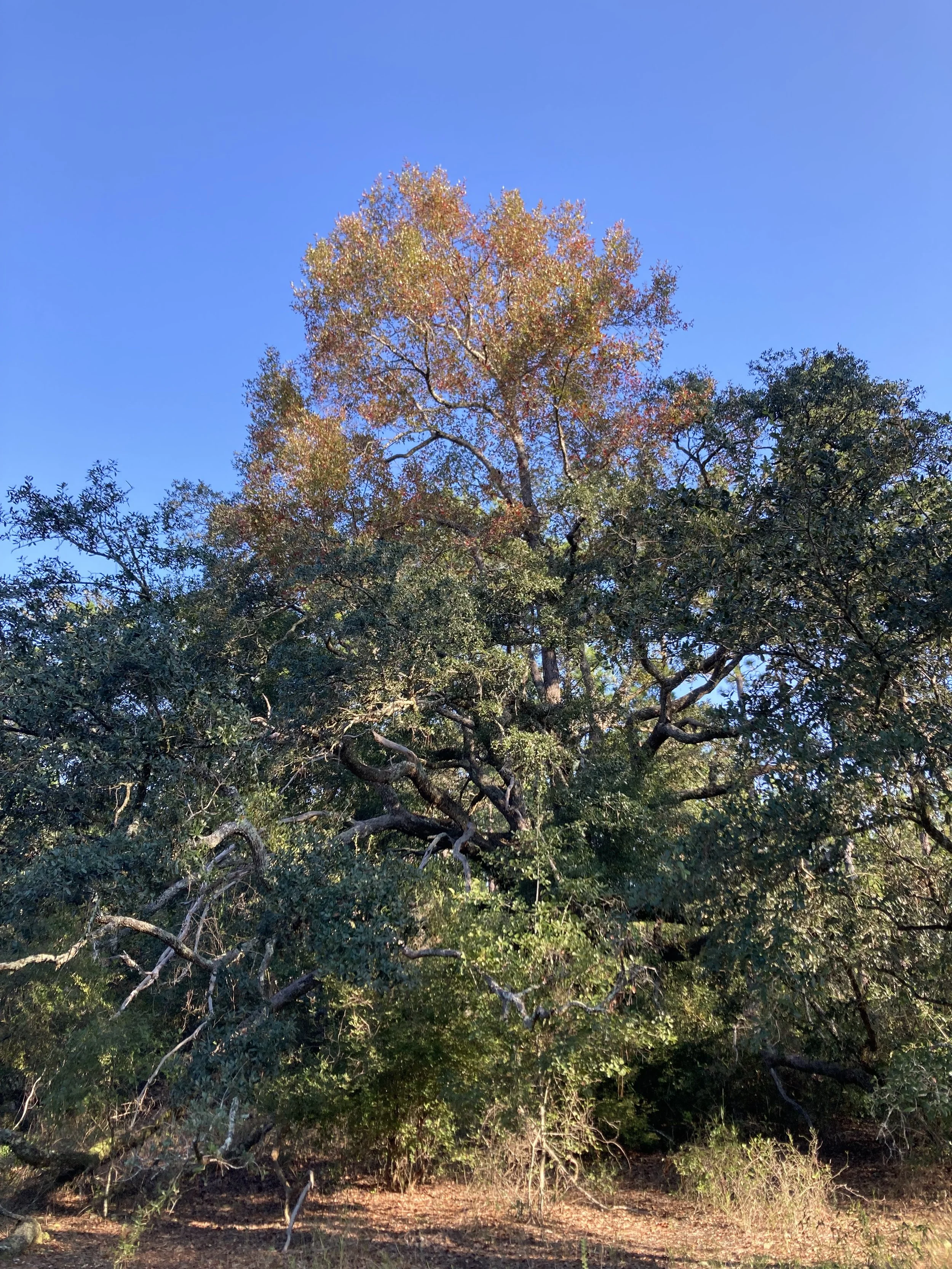I spent two hours communing with a black gum tree on Sunday morning.
Earlier in the week, I was biking the Munson Hills Trail with my wife and noticed a fruiting black gum on the edge of an ephemeral pond. I went back to see which birds were coming to it. I parked at the nearest trailhead, biked the short distance back out to the pond and got there at half past eight. I leaned my bike against a tree and started watching.
There are a lot of ephemeral ponds in the longleaf woods of the Munson Hills. Seasonally, they fill with rainwater and become important breeding areas for salamanders and tree frogs. Most of these ponds are roughly circular. This one was two hundred feet across and currently dry. In its center was a stand of buttonbush, which can handle inundation, surrounded by dog fennel. Then, a more open area of low grasses, meadow beauty and St. john’s-wort. At the edge of the pond there was a thin Goldilocks zone for upland plants, just high enough to be out of the water and just low enough to gain some fire protection. Along this edge grew a fairy ring of live oaks. Some were smaller, but one was old and large, around four feet in diameter.
The big oak was only about forty-feet tall, but very wide. Its first foot-thick horizontal limbs came out at head height and spread forty feet before touching the ground. Sheltered under its limbs was a thick growth of huckleberry, sparkleberry, and sapling oaks. Growing a few feet from the oak’s trunk was a black gum. It is likely that some bird that had been feeding in a distant gum tree had perched on an oak limb and deposited gum seeds with its droppings. The resulting gum tree had grown through the oak’s branches and was now sixty feet tall. Its lower branches intermingled with those of the oak, but most of its canopy jutted above it.
A black gum can live for hundreds of years. Its trunk was over a foot in diameter and it may have been growing there for a century. There are male and female gum trees and only the females bear fruit. Technically, gum fruits are drupes. A smaller version of a cherry, they have a single seed surrounded by fleshy pulp.
Black gum leaves begin to turn red when their dark fruits ripen in late September about the time of the autumnal equinox. The red leaves act as bird flags to attract feeding birds that distribute gum seeds in exchange for a meal of fruit pulp. It is a favored seasonal food for both resident and migrant birds.
I saw movement in the low shrubs beneath the oak and watched as a catbird branch-hopped up into the black gum and grabbed a fruit. A bright red summer tanager flew in and landed on an upper branch. It looked around and fluttered up to grab a drupe, using its own weight to pull it off. It landed on a branch for a moment with the fruit in its beak before swallowing it and looking for another. Among the gum’s branches I could see leaves jiggling as other birds fed. I found Northern Flicker and Red-bellied Woodpecker. The woodpeckers would hang in the branches and pull drupes off. A Northern Mockingbird landed on a branch, but was quickly chased off by a woodpecker, before it could feed.
Then, all the feeding birds flew off. During the time I watched, there were periods of inactivity punctuated by feeding forays from small flocks and individual birds. I saw movement in an upper branch as a Swainson’s Thrush fed. A small flock of bluebirds came in and chased each other through the canopy, stopping occasionally to grab a drupe. A pair of Blue Jays landed in the tree, but I did not see them go after the fruit.
Often, one of the low spreading oak branches would obscure my view. I started walking in a wide semicircle, changing position to get a better look at flitting birds. Usually, the best spot was the one that I had just been in and I ended up walking over a mile while making observations.
It was a pleasant and peaceful two hours to spend with a tree. In between bird sightings, I listened to the wind in the pines and watched the blue morning sky as Barn Swallows, Mourning Doves, a Chimney Swift, and a high-flying Red-headed Woodpecker passed overhead.
That black gum never actually spoke to me, but by watching it, I learned a lot about how it fits into the local ecosystem. In the end, I observed eight bird species feeding on the gum’s fruit; Red-bellied Woodpecker, Northern Flicker, White-eyed Vireo, Tufted Titmouse, Gray Catbird, Eastern Bluebird, Swainson’s Thrush, and Summer Tanager.
Not a bad way to spend a Sunday morning.

